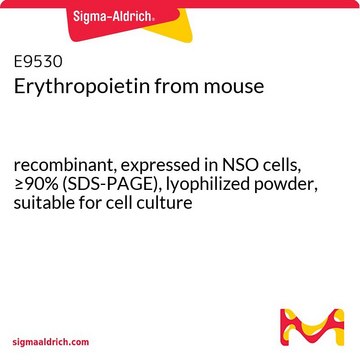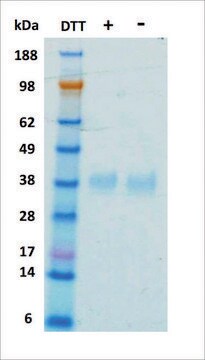H5166
Erythropoietin human
EPO, recombinant, expressed in HEK 293 cells, suitable for cell culture
Synonym(s):
EPO
Sign Into View Organizational & Contract Pricing
All Photos(1)
About This Item
Recommended Products
biological source
human
Quality Level
recombinant
expressed in HEK 293 cells
Assay
≥95% (SDS-PAGE)
form
lyophilized powder
potency
≤5.0 ng/mL ED50
quality
endotoxin tested
mol wt
dimer 36 kDa (glycosylated)
packaging
pkg of 10 μg
storage condition
avoid repeated freeze/thaw cycles
technique(s)
cell culture | mammalian: suitable
impurities
≤1 EU/μg
UniProt accession no.
storage temp.
−20°C
Gene Information
human ... EPO(2056)
Looking for similar products? Visit Product Comparison Guide
General description
EPO has been cloned from various species including human, murine, canine, and others. The mature proteins from the various species are highly conserved and exhibit greater than 80% amino acid sequence identity. EPO contains three N-linked glycosylation sites. The glycosylation of erythropoietin is required for the biological activities of erythropoietin in vivo.
Biochem/physiol Actions
Erythropoietin (EPO), produced primarily by the kidney, is the primary regulatory factor of erythropoiesis. It promotes the proliferation, differentiation, and survival of the erythroid progenitors. Erythropoietin stimulates erythropoiesis by inducing growth and differentiation of burst forming units and colony forming units into mature red blood cells. EPO produced by kidney cells is increased in response to hypoxia or anemia. The biological effects of erythropoietin are mediated by the erythropoietin receptor, which binds EPO with high affinity and is a potent EPO antagonist.
Erythropoietin is a glycoprotein that is the principal regulator of red blood cell growth and differentiation.
Preparation Note
Human EPO is expressed as a glycosylated 36 kDa monomer in human HEK 293 cells. Production in human HEK 293 cells offers authentic glycosylation. Glycosylation contributes to stability in cell growth media and other applications.
Analysis Note
The specific activity was determined by the dose-dependent stimulation of the proliferation of human TF-1 cells (human erythroleukemic indicator cell line).
Storage Class Code
11 - Combustible Solids
WGK
WGK 2
Flash Point(F)
Not applicable
Flash Point(C)
Not applicable
Choose from one of the most recent versions:
Already Own This Product?
Find documentation for the products that you have recently purchased in the Document Library.
Customers Also Viewed
Rajasekhar N V S Suragani et al.
Nature medicine, 20(4), 408-414 (2014-03-25)
Erythropoietin (EPO) stimulates proliferation of early-stage erythrocyte precursors and is widely used for the treatment of chronic anemia. However, several types of EPO-resistant anemia are characterized by defects in late-stage erythropoiesis, which is EPO independent. Here we investigated regulation of
Cynthia So-Osman et al.
Anesthesiology, 120(4), 839-851 (2014-01-16)
Patient blood management combines the use of several transfusion alternatives. Integrated use of erythropoietin, cell saver, and/or postoperative drain reinfusion devices on allogeneic erythrocyte use was evaluated using a restrictive transfusion threshold. In a factorial design, adult elective hip- and
François Roubille et al.
Cardiovascular drugs and therapy, 27(4), 315-331 (2013-05-23)
Erythropoietin (EPO) is the main hormone that regulates erythropoiesis. Beyond its well-known hematopoietic action, EPO has diverse cellular effects in non-hematopoietic tissues. It has been shown to inhibit apoptosis by activating pro-survival pathways in the myocardium, to mobilize endothelial progenitor
Russia Ha-Vinh Leuchter et al.
JAMA, 312(8), 817-824 (2014-08-27)
Premature infants are at risk of developing encephalopathy of prematurity, which is associated with long-term neurodevelopmental delay. Erythropoietin was shown to be neuroprotective in experimental and retrospective clinical studies. To determine if there is an association between early high-dose recombinant
H Franklin Bunn
Cold Spring Harbor perspectives in medicine, 3(3), a011619-a011619 (2013-03-05)
During the past century, few proteins have matched erythropoietin (Epo) in capturing the imagination of physiologists, molecular biologists, and, more recently, physicians and patients. Its appeal rests on its commanding role as the premier erythroid cytokine, the elegant mechanism underlying
Articles
Read article on hematopoietic cytokines and hematopoiesis
Our team of scientists has experience in all areas of research including Life Science, Material Science, Chemical Synthesis, Chromatography, Analytical and many others.
Contact Technical Service








